British pressure gear
Message 1450, 2 March 2001:
The suit worn with the Taylor helmet looks more like an anti-exposure suit than a standard
flight suit (the crotch zip in particular) . This apparently was not uncommon. But I would
not say it is an actual 'pressure suit'. Combination pressure jerkins/life preservers were
normally worn with the Taylor helmet. However, here is worn a standard orange life
preserver (looks to be Frankenstein mfg. RAF pattern). It also looks like he's got a pair
of 'internal' anti-g trousers on beneath the suit (seeing the number of hoses going into
the PEC. But it is possible a partial pressure suit is worn beneath the suit rather than a
g-suit. Anyone correct me if I'm wrong, but I don't believe the RAF ever issued a
partial-pressure suit. They had anti-g trousers, and used them in conjunction with
pressure jerkins if required. There were British- manufactured partial-pressure suits (I
have one in my collection) but I believe these were used by civil test pilots rather than
the RAF. Any thoughts, Doc Boink? Again, with the EFA helmeted pilot (and there were a
number of customized oxygen set-ups on EFA helmets depending on the nation, aircraft, etc)
it looks like another anti-exposure suit. And normally, it was mated to a Type 30 partial
pressure suit (which again could be worn beneath). The life preservers look to be the same
between both pilots. Nice pics...would love to see any more! Cheers Dave Clark 5
Message 1449, 2 March 2001:
Its quiz time folks, In 1968 trials were conducted in the Danish Air Force to determine
whether we should buy pressure suits for our F-104 interceptors and which type. Two types
were tested, one British and one French. The British helmet seems to be a Taylor Type E
and the French an EFA Type 23. The latter, however, has a different oxygen connection than
the one shown in Jet Age Flight Helmets on page 151. Anyone who could identify the suits
and helmets shown in the enclosed (mediocre) photos? Any other comments on the flight
gear? Cheers, Bluelight 14
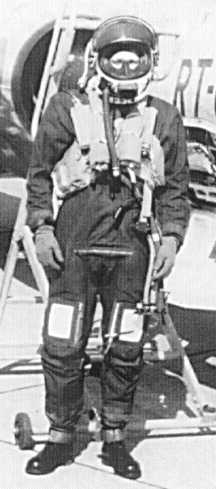

Message 1369, 24 February 2001:
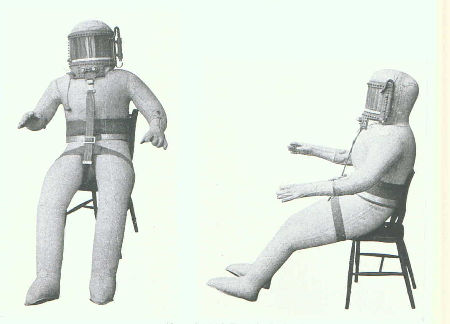 Thought that perhaps you would find a few of the following
excerpts of interest. These are drawn from Dr. Harry Armstrong's book "Aviation
Medicine", dated 1943. Armstrong, one of the American leading lights in early
aerospace medicine (aviation medicine at that time, of course) is the namesake of the USAF
School of Aerospace Medicine's Armstrong Lab. Although Dr. Armstrong was recognized for
his excellent work in high altitude physiology, his view on the future of flightgear
weren't all right on target (see following statements taken from his book). On
pressure suits: Armstrong describes the Royal Air Force development of an earlier
Siebe-Gorman pressure suit design for Mark Ridge, an American balloonist who had the idea
of using a sort of modified deep sea diving suit for ascents to high altitude in a
balloon; although the suit developed for Ridge was hypobarically tested to a simulated
altitude of 36,500 feet, and despite the fact that the subsequent RAF version allowed one
Flight Lt. Adam to reach a record high of 53,937 feet on 6 Jun 1936, Armstrong goes on to
state: "This accomplishment of the English airmen was a practical demonstration of
the fact that oxygen-pressure suits are capable of use in aircraft at extremely high
altitude for such ventures as they undertook. On the other hand, such equipment is
entirely unsuited to commercial aviation and of very limited, if any, value in military
aviation. The reason for this should be quite obvious although there are many who
still advocate its use in military aviation, citing as its advantages its lightness and
small target area. Against these meritorious advantages, however, are certain
disadvantages which appear insurmountable. Chief among them is the fact that such a suit
is cumbersome, difficult to put on and take off, markedly restricts the field of vision,
and when inflated becomes rigid and distended and immobilizes the wearer. If one
visualises a gunner attempting to swing a flexible machine gun while encased in such a
contrivance, the fallacy of such a suit for military use should at once become
apparent." While the famous Wiley Post pressure suit is fairly
well known, the RAF development stemming from Ridge's original suit (referenced
above) is not as frequently seen. [The attached images show the RAF suit that Dr.
Armstrong so confidently dismissed as being "unsuitable."]
The lesson here, I suppose, is that even though a person may have achieved
substantial fame and recognition in his professional field, this doesn't necessarily
enable him to accurately predict future developments. (In fairness, it should be
noted that the chief limitation of pressure suit designs of the 30s and 40s were
largely attributable to limitations of materials technology available at that time).
Cheers, DocBoink
Thought that perhaps you would find a few of the following
excerpts of interest. These are drawn from Dr. Harry Armstrong's book "Aviation
Medicine", dated 1943. Armstrong, one of the American leading lights in early
aerospace medicine (aviation medicine at that time, of course) is the namesake of the USAF
School of Aerospace Medicine's Armstrong Lab. Although Dr. Armstrong was recognized for
his excellent work in high altitude physiology, his view on the future of flightgear
weren't all right on target (see following statements taken from his book). On
pressure suits: Armstrong describes the Royal Air Force development of an earlier
Siebe-Gorman pressure suit design for Mark Ridge, an American balloonist who had the idea
of using a sort of modified deep sea diving suit for ascents to high altitude in a
balloon; although the suit developed for Ridge was hypobarically tested to a simulated
altitude of 36,500 feet, and despite the fact that the subsequent RAF version allowed one
Flight Lt. Adam to reach a record high of 53,937 feet on 6 Jun 1936, Armstrong goes on to
state: "This accomplishment of the English airmen was a practical demonstration of
the fact that oxygen-pressure suits are capable of use in aircraft at extremely high
altitude for such ventures as they undertook. On the other hand, such equipment is
entirely unsuited to commercial aviation and of very limited, if any, value in military
aviation. The reason for this should be quite obvious although there are many who
still advocate its use in military aviation, citing as its advantages its lightness and
small target area. Against these meritorious advantages, however, are certain
disadvantages which appear insurmountable. Chief among them is the fact that such a suit
is cumbersome, difficult to put on and take off, markedly restricts the field of vision,
and when inflated becomes rigid and distended and immobilizes the wearer. If one
visualises a gunner attempting to swing a flexible machine gun while encased in such a
contrivance, the fallacy of such a suit for military use should at once become
apparent." While the famous Wiley Post pressure suit is fairly
well known, the RAF development stemming from Ridge's original suit (referenced
above) is not as frequently seen. [The attached images show the RAF suit that Dr.
Armstrong so confidently dismissed as being "unsuitable."]
The lesson here, I suppose, is that even though a person may have achieved
substantial fame and recognition in his professional field, this doesn't necessarily
enable him to accurately predict future developments. (In fairness, it should be
noted that the chief limitation of pressure suit designs of the 30s and 40s were
largely attributable to limitations of materials technology available at that time).
Cheers, DocBoink
Message 484, 1 November 2000:
Thanks for the information on the Victoria Rubber Works partial pressure suit, Christian.
Interesting to know that the Concorde prototype flight tests were carried out using the
Victoria suit, also (I knew that they used the ML Aviation Type 12P Mk IV helmet). Thanks
again. Your collection of the Taylor and ML Aviation helmets is undoubtedly unsurpassed
for these types. Cheers, Chris
Message 483, 31 October 2000:
The suit you have was officially mated to the Taylor Partial Pressure helmet by the RAF
for use in the Lightning aircraft. I do not know of any long term useage of this
combination as the Pressure Jerkin with Anti-g trousers was the combination much prefered
for use with the Taylor Helmet. The surplus of these suits must have suited the Concorde
aircrew as they were worn with the M.L.Aviation Helmet as seen in photos of Concorde
testing. Maybe the RAF wouldn't release the Pressure Jerkin as they were certainly in use
by them, at this time, as they still are with the PR.9 Canberra aircraft today! Christian.
Message 475, 30 October 2000:
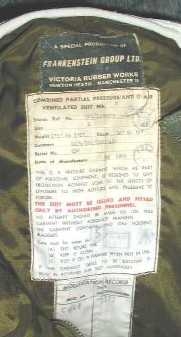
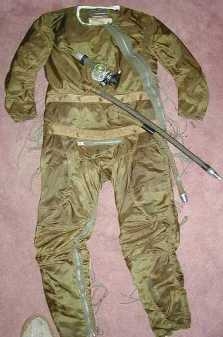 Have you any information on a bladder type partial pressure
suit produced by the Victoria Rubber Works in UK, that may have been used with the ML
Aviation helmets? I obtained an ML Aviation Type 12P, Mk.IVC partial pressure helmet that
came with an English bladder type partial pressure suit that the inner label described
only as "Combined partial Pressure/Anti-G/Air-Ventilated Suit Mk.II", made by
the Victoria Rubber Works (Frankenstein Group Ltd., Newton Heath, Manchester). I attach an
image of the label. The helmet and suit were a set, although you state that the MLA
helmets were never used by the RAF. This is most interesting for me, as it was this very
type of suit that was supposed to have been so influential in later (1970s and 80s)
Armstrong labs research studies that resulted in the Combat Edge & TLSS gear. I have
attached a few images of the suit in reference.
Have you any information on a bladder type partial pressure
suit produced by the Victoria Rubber Works in UK, that may have been used with the ML
Aviation helmets? I obtained an ML Aviation Type 12P, Mk.IVC partial pressure helmet that
came with an English bladder type partial pressure suit that the inner label described
only as "Combined partial Pressure/Anti-G/Air-Ventilated Suit Mk.II", made by
the Victoria Rubber Works (Frankenstein Group Ltd., Newton Heath, Manchester). I attach an
image of the label. The helmet and suit were a set, although you state that the MLA
helmets were never used by the RAF. This is most interesting for me, as it was this very
type of suit that was supposed to have been so influential in later (1970s and 80s)
Armstrong labs research studies that resulted in the Combat Edge & TLSS gear. I have
attached a few images of the suit in reference.
What seems strange to me is that, assuming the MLA helmets weren't used at all by the RAF
(although used briefly in Concorde test programme), what was it doing mated to Victoria
Rubber Works suit? Any insights into this intriguing matter? I hope you are able to read
the label inscription in the attached images (both are thumbnails; press to see larger
images). Cheers, Chris
Message 470, 30 October 2000:
Hi Chris and fellow Flightgear members, Just to let you know that the Taylor helmet was
fitted with two different types of rear crash protection plates. One was hinged like the
M.L.Aviation helmet from the top and the other was hinged from the side. One example as
used by the Swedish Airforce was recently auctioned on e-bay but I am afraid the prices
reached there are way out of my range!
From the RAF Institute of Aviation Medicine Report No.617, it clearly tells that although
Taylor and M.L. helmets looked similar in design they had no association with each other
in the design of their helmets. In actual fact the two companies were at opposite ends of
the country to each other! The Taylor helmet entered service with the RAF but the M.L.
helmet did not. The M.L. helmet did enter service with the German Airforce though with the
Starfighter and was used during development work with Concorde.
For all you interested collectors I have attached two shots of the two types of hinged
crash protection plates as fitted to Taylor helmets. I was very lucky to have obtained all
the collection of over 200 photographs plus some colour slides of the helmets and suits as
manufactured by Baxter, Woodhouse and Taylor, to give the firm its full title, from
Annette and Michael Bingham, the daughter and son-in-law of Bill Taylor. I have also
attached a shot of some of my Pressure helmet collection which contains seven different
Taylor and three different type M.L.Aviation Pressure helmets. Very good collecting to you
all, Christian Brydges
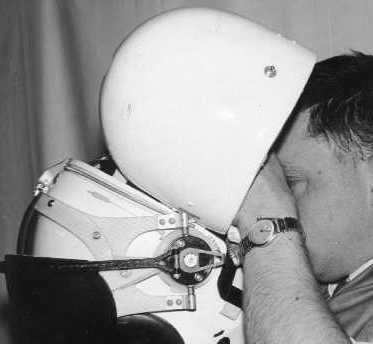

Taylor side-hinged crash protection plate (left) and top-hinged (right). Both pictures are
thumbnails.
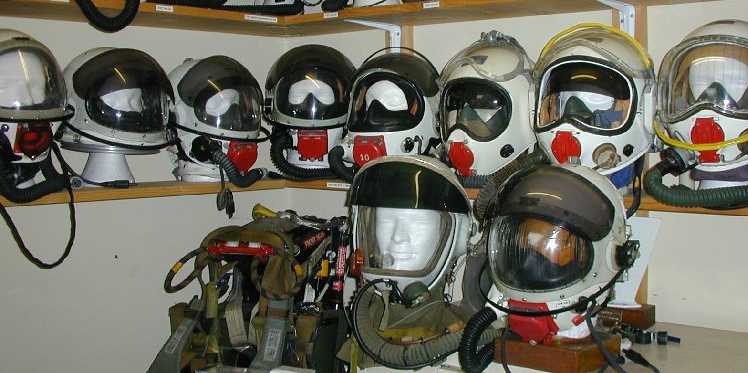


 Thought that perhaps you would find a few of the following
excerpts of interest. These are drawn from Dr. Harry Armstrong's book "Aviation
Medicine", dated 1943. Armstrong, one of the American leading lights in early
aerospace medicine (aviation medicine at that time, of course) is the namesake of the USAF
School of Aerospace Medicine's Armstrong Lab. Although Dr. Armstrong was recognized for
his excellent work in high altitude physiology, his view on the future of flightgear
weren't all right on target (see following statements taken from his book). On
pressure suits: Armstrong describes the Royal Air Force development of an earlier
Siebe-Gorman pressure suit design for Mark Ridge, an American balloonist who had the idea
of using a sort of modified deep sea diving suit for ascents to high altitude in a
balloon; although the suit developed for Ridge was hypobarically tested to a simulated
altitude of 36,500 feet, and despite the fact that the subsequent RAF version allowed one
Flight Lt. Adam to reach a record high of 53,937 feet on 6 Jun 1936, Armstrong goes on to
state: "This accomplishment of the English airmen was a practical demonstration of
the fact that oxygen-pressure suits are capable of use in aircraft at extremely high
altitude for such ventures as they undertook. On the other hand, such equipment is
entirely unsuited to commercial aviation and of very limited, if any, value in military
aviation. The reason for this should be quite obvious although there are many who
still advocate its use in military aviation, citing as its advantages its lightness and
small target area. Against these meritorious advantages, however, are certain
disadvantages which appear insurmountable. Chief among them is the fact that such a suit
is cumbersome, difficult to put on and take off, markedly restricts the field of vision,
and when inflated becomes rigid and distended and immobilizes the wearer. If one
visualises a gunner attempting to swing a flexible machine gun while encased in such a
contrivance, the fallacy of such a suit for military use should at once become
apparent." While the famous Wiley Post pressure suit is fairly
well known, the RAF development stemming from Ridge's original suit (referenced
above) is not as frequently seen. [The attached images show the RAF suit that Dr.
Armstrong so confidently dismissed as being "unsuitable."]
The lesson here, I suppose, is that even though a person may have achieved
substantial fame and recognition in his professional field, this doesn't necessarily
enable him to accurately predict future developments. (In fairness, it should be
noted that the chief limitation of pressure suit designs of the 30s and 40s were
largely attributable to limitations of materials technology available at that time).
Cheers, DocBoink
Thought that perhaps you would find a few of the following
excerpts of interest. These are drawn from Dr. Harry Armstrong's book "Aviation
Medicine", dated 1943. Armstrong, one of the American leading lights in early
aerospace medicine (aviation medicine at that time, of course) is the namesake of the USAF
School of Aerospace Medicine's Armstrong Lab. Although Dr. Armstrong was recognized for
his excellent work in high altitude physiology, his view on the future of flightgear
weren't all right on target (see following statements taken from his book). On
pressure suits: Armstrong describes the Royal Air Force development of an earlier
Siebe-Gorman pressure suit design for Mark Ridge, an American balloonist who had the idea
of using a sort of modified deep sea diving suit for ascents to high altitude in a
balloon; although the suit developed for Ridge was hypobarically tested to a simulated
altitude of 36,500 feet, and despite the fact that the subsequent RAF version allowed one
Flight Lt. Adam to reach a record high of 53,937 feet on 6 Jun 1936, Armstrong goes on to
state: "This accomplishment of the English airmen was a practical demonstration of
the fact that oxygen-pressure suits are capable of use in aircraft at extremely high
altitude for such ventures as they undertook. On the other hand, such equipment is
entirely unsuited to commercial aviation and of very limited, if any, value in military
aviation. The reason for this should be quite obvious although there are many who
still advocate its use in military aviation, citing as its advantages its lightness and
small target area. Against these meritorious advantages, however, are certain
disadvantages which appear insurmountable. Chief among them is the fact that such a suit
is cumbersome, difficult to put on and take off, markedly restricts the field of vision,
and when inflated becomes rigid and distended and immobilizes the wearer. If one
visualises a gunner attempting to swing a flexible machine gun while encased in such a
contrivance, the fallacy of such a suit for military use should at once become
apparent." While the famous Wiley Post pressure suit is fairly
well known, the RAF development stemming from Ridge's original suit (referenced
above) is not as frequently seen. [The attached images show the RAF suit that Dr.
Armstrong so confidently dismissed as being "unsuitable."]
The lesson here, I suppose, is that even though a person may have achieved
substantial fame and recognition in his professional field, this doesn't necessarily
enable him to accurately predict future developments. (In fairness, it should be
noted that the chief limitation of pressure suit designs of the 30s and 40s were
largely attributable to limitations of materials technology available at that time).
Cheers, DocBoink



